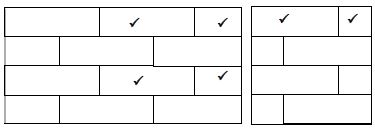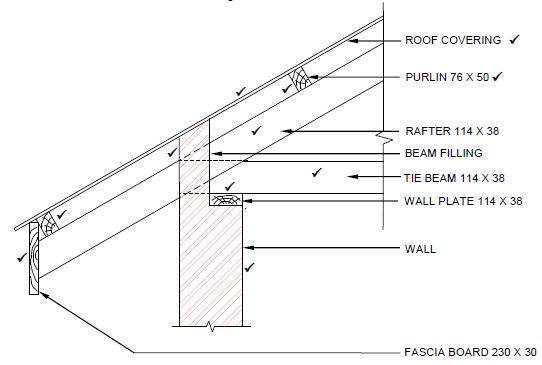CIVIL TECHNOLOGY: CONSTRUCTION GRADE 12 MEMORANDUM - NSC EXAMS PAST PAPERS AND MEMOS NOVEMBER 2018
Share via Whatsapp Join our WhatsApp Group Join our Telegram GroupCIVIL TECHNOLOGY: CONSTRUCTION
GRADE 12
NSC EXAMS
PAST PAPERS AND MEMOS
NOVEMBER 2018
MEMORANDUM
QUESTION 1: OHSA, MATERIALS, TOOLS, EQUIPMENT AND JOINING (GENERIC)
1.1
1.1.1 F ✔ (1)
1.1.2 A ✔ (1)
1.1.3 G ✔ (1)
1.1.4 E ✔ (1)
1.1.5 B ✔ (1)
1.2
- Do not throw any tools or materials from a scaffold. ✔
- Never jump on to and off a scaffold. ✔
- Never overload a scaffold.
- Remove or cover sharp edges or corners.
- Always attach free-standing scaffoldings to a building.
- Use a ladder to get on and off a scaffold.
- Keep free of waste or any other obstruction.
- Never jump on a scaffold while working on it.
- Responsible/qualified person must ensure that scaffolding is safe, rigid, stable and firm or has no defects.
- Scaffold must be supplied with guard rails/toe boards.
- Scaffolds must be levelled on uneven ground.
- Do not work on a scaffold in bad weather.
- Wear a safety harness when working on scaffolding.
- Do not throw tools on/off a scaffold.
ANY TWO OF THE ABOVE (2)
1.3
- It prevents workers from falling off the scaffold. ✔
- It is used as a handrail. ✔
- It is used to strap on safety harnesses.
- To protect the worker working on the scaffold.
ANY TWO OF THE ABOVE (2)
1.4
- The primary purpose of painting is to protect metals, wood and other material against corrosion and decay. ✔
- Provides a decorative/aesthetic appearance/finishing. ✔
- Protects surfaces from moisture penetration.
- Protects surfaces from rust/uv rays.
ANY TWO OF THE ABOVE (2)
1.5 The curing of concrete:
- Increases the strength of concrete. ✔
- Decreases the permeability of hardened concrete.
- Improves durability of concrete by reducing cracks.
- Makes concrete more watertight.
- Minimises shrinkage cracks in concrete.
- Provides volume stability.
- Cured concrete can carry more weight without breaking/crumbling than uncured concrete.
- Prevents rapid drying of concrete.
- Curing ensures that the hydration process continues.
ANY ONE OF THE ABOVE (1)
1.6
1.6.1 Multi detector ✔ (1)
1.6.2 Tool A is used:
- to detect materials found in/behind walls, ceilings and underneath floors, including ferrous and non-ferrous metals, electrical wiring, wood and metal studs. ✔
- to locate steel bars and copper pipes. ✔
- in carpentry, plumbing, and construction.
- to measure the distance to/from covered objects.
ANY TWO OF THE ABOVE (2)
1.6.3 The batteries must be removed from the tool:
- to prevent the battery from running flat/battery can die. ✔
- to prevent acid leaks from batteries damaging the tool.
ANY ONE OF THE ABOVE (1) 1.7
1.7.1 A – Bolt and nut/Bolt ✔
B – Rawl bolt ✔ (2)
1.7.2 Bolt and nut
- Bolts and nuts are used to secure pipe supports to metal parts. ✔
- To join components together.
Rawl bolt
- A Rawl bolt is used to fix a truss hanger to a wall. ✔
- To fix brackets/structures/panels to a wall/concrete.
- For construction, renovation and industrial work
ANY TWO OF THE ABOVE (2) [20]
QUESTION 2: GRAPHICS AS METHOD OF COMMUNICATION (GENERIC)
ANSWER SHEET 2
NO. | QUESTIONS | ANSWERS | MARKS |
1 | Identify FIGURE A. | South Elevation/Elevation ✔ | 1 |
2 | Identify FIGURE B. | Ground floor plan/floorplan ✔ | 1 |
3 | Identify number 4. | First floor level/Second floor level/Suspended floor/Floor level/ dash line/ FFL/Expansion joint ✔ | 1 |
4 | Identify number 5. | Window Sill ✔ | 1 |
5 | Identify number 9. | Hand wash basin/Wash basin/Washing basin/HWB/basin ✔ | 1 |
6 | Identify number 10. | Water closet/WC/Toilet pan ✔ | 1 |
7 | Identify number 11. | Bath/B ✔ | 1 |
8 | On what date was the plan printed? | 2018/10/02 ✔ | 1 |
9 | Who drew the building plan? | JP Maloi ✔ | 1 |
10 | Name the feature in the column for the notes in FIGURE 2 that must be installed in front of the sliding door. | Ramp ✔ | 1 |
11 | Name the feature in the column for the notes in FIGURE 2 that must give access to the first floor. | Staircase/Stairs/Stairway✔ | 1 |
12 | Identify the type of roof that is used for the building in FIGURE A. | Gable roof ✔ | 1 |
13 | Explain the purpose of number 1. | To cover the opening/close the gap between the two slopes of the roof. ✔ | 1 |
| MARKS | |||
14 | Explain the purpose of number 2. |
| 1 |
15 | Explain the abbreviation FFL at number 6. | Finished floor level ✔ | 1 |
16 | Explain the purpose of number 7. | To channel the water from the gutter to the ground. ✔ | 1 |
17 | Explain the meaning of the arrow on the feature that must be installed in front of the sliding door. | It indicates the direction of the slope of the ramp/it indicates the slope. ✔ | 1 |
18 | Explain what is meant by 1:10 indicated on the symbol in the notes. | It indicates the slope or the gradient of the ramp/for every 10 metres horizontally rises 1 metre vertically.✔ | 1 |
19 | Which room will feature 15 serve? | The bathroom. ✔ | 1 |
20 | Explain the short dash lines on the windows. |
| 1 |
21 | Deduce the height of window 2 from the window schedule. | 1,2 m or 1 200 mm ✔(Ignore units) | 1 |
22 | Deduce the width of window 3 from the window schedule. | 2 m or 2 000 mm ✔(Ignore units) | 1 |
23 | On what elevation of the building is the bathroom window situated? | Western elevation/Western side ✔ | 1 |
24 | Differentiate between component number 3 and component number 8. | 3 – window/window frame/reveal frame stile/casement stile ✔ | 2 |
| MARKS | |||
25 | Differentiate between the light in the lounge and the light in the bathroom. | The light in the lounge is a fluorescent light/1 x 40W/2x40/3x40 fluorescent light ✔ and the light in the bathroom is a normal ceiling light ✔ | 2 |
26 | Recommend a suitable floor covering for the bathroom. | Tile/ Vinyl flooring (Novilon)/ Coloured screed/Polished or stained concrete flooring/Water proof laminated floor/carpet. ✔ | 1 |
27 | Recommend an appropriate scale to which FIGURE A should be drawn, according to SANS. | 1:50/100/200 ✔ | 1 |
28 | Recommend an alternative sanitary fitment to replace number 11 that will serve a similar purpose. | Shower ✔ | 1 |
29 | Calculate the internal area of the office in m² Show ALL calculations. | 4 m ✔ x 3 m ✔ = 12 m² ✔ OR 12 4 000✔ X 3 000✔ = 12 000 000mm2 | 3 |
30 | Calculate the perimeter of the building. Show ALL calculations. | Positive marking | 7 |
TOTAL | 40 |
QUESTION 3: ROOFS, STAIRCASES AND JOINING (SPECIFIC)
3.1 5°/10/30° ✔ (1)
3.2 1 400 mm ✔ (1)
3.3 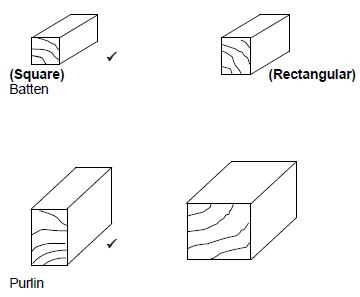
ANY ONE OF THE ABOVE
3.4 50 mm x 76 mm/ 76 mm x 50 mm ✔ OR 76 mm x 76 mm (1)
3.5 (2)
Clay roof tiles | Fibre cement tiles |
650 mm/closer together ✔ | 760 mm/ further apart ✔ |
3.6
A - Ridge capping/Ridge plate/Roof capping ✔
B - Roof covering/Corrugated iron roof/IBR iron roof/roof sheeting ✔
C - Gang nail/Nail plate/Connector plate/Joining piece ✔
D - King post ✔ (4)
3.7 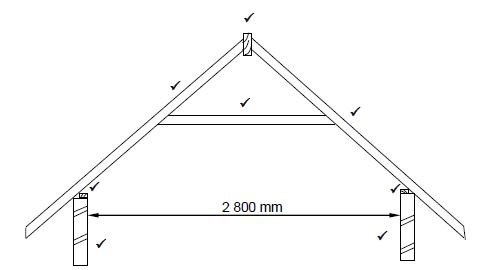
ASSESSMENT CRITERIA | MARK | CANDIDATE'S MARK |
Walls | 2 | |
Wall plates (Wrong position – 1 mark) | 2 | |
Rafters | 2 | |
Collar beam/Collar tie | 1 | |
Ridge beam correctly drawn | 1 | |
TOTAL: | 8 |
3.8.1 Riser ✔ (1)
3.8.2 Balusters ✔ (1)
3.8.3 Going/Tread ✔ (1)
3.8.4 Landing ✔ (1)
3.8.5 Run ✔ (1)
3.9 
ANY TWO OF THE ABOVE OR ANY OTHER SHAPE RESEMBLING A SQUARE OR ROUND SHAPE/ 2 AND 3 DIMENSIONAL DRAWINGS ACCEPTABLE
3.10
- Screwed on to the face of the wall. ✔
- By means of a bracket.
- Fixed to face of wall using Rawl bolts or sleeved anchors by means of a bracket.
ANY ONE OF THE ABOVE (1)
3.11
- Timber that is bolted to the top of the wall.✔
- Nailed or screwed to the wall. ✔
- A galvanised strap/hoop iron nailed or built into the wall.
- Tie with roof wire built into wall.
ANY TWO OF THE ABOVE (2)
3.12
- Supports the steel and withstands the loads. ✔
- The pin serves as a pivoting point to adjust the angle or to lower the steel section.
- The pin can be removed to separate the steel section from the base.
- To keep the steel section attached to the base plate/concrete base.
ANY ONE OF THE ABOVE (1) [30]
QUESTION 4: EXCAVATIONS, FORMWORK, TOOLS AND EQUIPMENT AND MATERIALS (SPECIFIC)
4.1
4.1.1 C ✔
4.1.2 D ✔
4.1.3 F ✔
4.1.4 E ✔
4.1.5 A ✔ (5)
4.2.1
- Keep excavated soil away from edge at least 600 mm. ✔
- Identify any equipment that will affect trench stability. ✔
- Trenches should be inspected at the start of each shift. ✔
- Trenches should be inspected after a rain storm.
- No worker will be allowed to work or move in trenches deeper then 1,5 metres if the sides are not protected by formwork or braced.
- Test for atmospheric hazards (low oxygen, hazardous fumes and toxic gases) when trenches are more than 1,3 metres deep.
- No load vehicle or plant equipment should be used, placed driven or used on or near the edge of any excavation where it is likely to cause a collapse and endanger workers lives.
- A warning system for mobile equipment should be provided.
- Always protect workers from loose rock or soil that could fall or roll from an excavation by installing protective barricades at appropriate intervals.
- Prohibit workers from working on faces of slopes or benched excavations at levels above other workers, unless workers at a lower level is protected against hazards of falling or sliding material or equipment.
- Members/parts of the support system (formwork or shuttering) should be securely connected to prevent sliding, falling material.
- Avoid overloading members of support systems.
- Formwork/shuttering should be removed in a manner that will protect workers from cave-ins.
- Before temporary removal of individual formwork members/parts, additional precautions should be in place, installing other structural members.
- Backfilling should always progress with the removal of the support system (formwork from the excavation).
- The area should be cordoned off and warning signs must be posted and must be clearly visible.
- Cover the entire work area after hours, especially if children might gain entry to the site.
- A suitable barrier(fence) must be provided where any excavation is more than 2 metres deep.
- Excavation sites should be well lit at night.
- Red warning lights should be placed strategically to warn the public.
- Workers should not work under suspended or raised loads of materials.
- Always start dismantling the formwork from the bottom of the formwork.
- Never work alone in deep excavations.
ANY THREE OF THE ABOVE (3)
4.2.2
- The site must be levelled. ✔
- The site must be cleared properly, and all loose soil must be removed.✔
- A baseline must be established. ✔ (3)
4.3 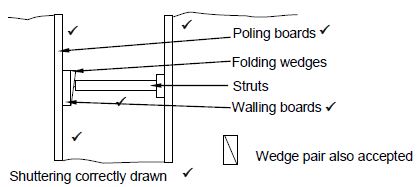
ASSESSMENT CRITERIA | MARK | CANDIDATE'S MARK |
Folding wedges | 1 | |
Walling boards | 1 | |
Poling boards | 2 | |
Struts | 1 | |
Shuttering correctly drawn | 1 | |
Any TWO labels | 2 | |
TOTAL: | 8 |
4.4 Good formwork should be:
- made accurately to the dimensions. ✔
- stable enough to bear the load of wet concrete.
- bear the mass of workers on it.
- able to withstand the vibrating and tamping of concrete.
- strong enough to provide enough support, without too much deflection, until the concrete has set and cured.
- easy to repair on site.
- secured with wire nails so that it can be easily dismantled.
- secured with bolts and nuts ranging from 13 mm to 19 mm in diameter.
- should be sealed properly.
- should be free of dirt such as saw dust.
- quick and simple to erect to ensure the correct cover depth for the reinforcing.
- removed only when concrete has cured.
- close-fittings along seams and joints.
- made of recyclable components.
- fitted with plywood laggings for a smooth finish.
- ensure the correct cover depth for the reinforcing in order to prevent structural failure.
- sealed properly so that the concrete does not leak and form a honeycomb effect.
ANY ONE OF THE ABOVE (1)
4.5
4.5.1 Beam formwork/Formwork for beams✔ (1)
4.5.2
A - Tie 50 mm x 25 mm at 600 mm centres ✔
B - Cleat 76 mm x 50 mm ✔
C - Fixing plate/Kicker plate 76 mm x 50 mm ✔
D - Brace/Strut 76 mm x 25 mm ✔ (4)
4.5.3
- The shape of folding wedges simplifies the erecting and dismantling of formwork. ✔
- Folding wedges can easily be removed by knocking one away from the other.
- Folding wedges help to keep formwork components sturdy/secured/stable.
- Folding wedges play an important role in the levelling of formwork for beams, floor slabs and columns.
- Folding wedges facilitate the raising or lowering of the formwork to the required height.
- Folding wedges are used as pins to strengthen adjoining concrete formwork (1)
ANY ONE OF THE ABOVE
4.6
- Sturdy/Rigid enough to bear the mass of wet concrete without collapsing.✔
- Stronger than wood and timber board products. ✔
- Easily removed when the concrete has set.
- Not as adaptable as timber shuttering.
- More expensive than timber.
- Will last longer than timber.
- Can be used repeatedly.
- Tight along the seams and joints so that concrete does not leak.
- It’s prone to rust.
ANY TWO OF THE ABOVE (2)
4.7
4.7.1
- Operate with care and wear appropriate personal protective equipment. ✔
- Check the controls for proper response before use.✔
- Check the condition of the machine at the start and end of each shift.
- Never use a faulty machine.
- Never lay the machine on its side.
- Do not allow the vibrating pipe to make contact with any part of the body or formwork.
- Switch of the machine when it is left unattended.
- Long use of the machine exposes the operator to vibrations. Stop if you feel numbness.
- Switch off the machine and wait for all moving parts to stop before adjusting, repairing, inspecting or cleaning it.
- Must be operated by a qualified person. (2)
ANY TWO OF THE ABOVE
4.7.2
- Maintain like all machinery. Lubricate and adjust according to the manufacturer’s instruction. ✔
- Clean after use and store in a safe dry place. ✔
- Service the concrete vibrator regularly.
- Repair or replace damaged electric cords.(2)
ANY TWO OF THE ABOVE
4.8
- Service the tamping rammer/plate compactor regularly. ✔
- Remove loose dirt and soil after use. ✔
- Maintain like all machinery, lubricate and adjust according to the manufacturers instruction.
- Clean after use.
- Store in a safe dry place.
- Ensure that all parts are firmly attached to the machine.
- Repair or replace damaged electric cords. (2)
ANY TWO OF THE ABOVE
4.9 Ready-mix concrete:
- is very expensive. ✔
- delivery and pouring delays may affect the quality of the concrete. ✔
- site batching in residential areas raises concerns about noise levels
- must be poured within a specified time.
- trucks may damage or soil house frontages and sidewalks.
- contaminations of storm-water drains.
ANY TWO OF THE ABOVE (2)
4.10 The purpose of the slump test:
- is to test the density of the concrete before it is placed by determining the percentage of water it contains. ✔
- Is to determine the workability and consistency of the batches that are mixed. ✔
- To determine the slump of the mixture.
ANY TWO OF THE ABOVE (2)
4.11
- Water – hosepipe or continuous spraying ✔
- Water- retaining substances, such as damp sand, damp sacking, straw, hessian and canvas. ✔
- Plastic membranes and plastic sheeting
- Chemical curing products
ANY TWO OF THE ABOVE (2) [40]
QUESTION 5: PLASTER AND SCREED, BRICKWORK AND GRAPHICS AS MEANS OF COMMUNICATION (SPECIFIC)
5.1
5.1.1
A - Wet the wall thoroughly ✔
B - Apply plaster ✔
C - Scrape the plaster to obtain a flat surface/levelling ✔
D - Float to smooth the surface ✔ (4)
5.1.2 Straight edge ✔ (1)
5.2
LEFT VIEW INCORRECTLY DRAWN -1 (6)
CRITERIA ASSESSMENT | MARK | CANDIDATE'S MARK |
Full bricks and ½ brick every alternate course on front view | 4 | |
Left view full brick every course | 1 | |
Left view ¼ brick every course | 1 | |
TOTAL: | 6 |
5.3
5.3.1
A- Herring bone paving pattern ✔
B- Basket-weave paving pattern ✔ (2)
5.3.2
- Dry-laid or sand-set ✔
- Bitumen-set
- Mortar-set
ANY ONE OF THE ABOVE (1)
5.3.3
- River/Plaster sand is used to grout between paving bricks.
- Sand mixed with cement is used to grout between paving bricks ✔
ANY ONE OF THE ABOVE (1)
5.4
SCALE: 1:10 ✔
NOT DRAWN TO SCALE
APPLICATION OF SCALE ✔ ✔✔
USE A MASK TO MARK THIS QUESTION ACCEPT ANY ANGLE BETWEEN 30° AND 45°.
ASSESSMENT CRITERIA | MARK | CANDIDATE'S MARK |
Wall: 220 mm wide face brick | 1 | |
Beam filling | 1 | |
Wall plate 114 mm x 38 mm | 1 | |
Tie beam 114 mm x 38 mm | 1 | |
Rafter 114 mm x 38 mm | 1 | |
Purlins 76 mm x 50 mm | 2 | |
Corrugated iron roof covering | 1 | |
Fascia board 230 mm x 38 mm | 1 | |
Any TWO labels | 2 | |
Print the scale below the drawing | 1 | |
Application of scale | 3 | |
TOTAL | 15 |
(15) [30]
QUESTION 6: REINFORCEMENT IN CONCRETE, FOUNDATIONS, CONCRETE FLOOR AND QUANTITIES (SPECIFIC)
6.1
6.1.1 B ✔ (1)
6.1.2 D ✔ (1)
6.1.3 D ✔ (1)
6.1.4 B ✔ (1)
6.1.5 A ✔ (1)
6.2 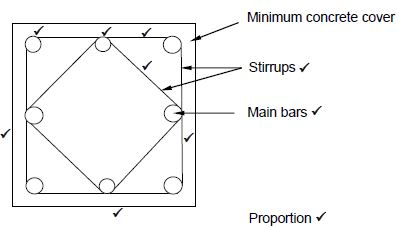
ASSESSMENT CRITERIA | MARK | CANDIDATE'S MARK |
Column | 2 | |
8 Main bars | 2 | |
Binders/Stirrups | 2 | |
Min concrete cover | 1 | |
Any TWO Labels | 2 | |
Proportion | 1 | |
TOTAL | 10 |
6.3 Pile foundations:
- can be used in poor/unstable/soft/loose soil. ✔
- can be used anywhere even in water. ✔
- the larger base ensures stability. ✔
- is relatively quick to install if the equipment is available.
- where pre-fabricated piles are used, much time is saved.
- resists tensile stress well.
- is quick and less expensive to produce.
- can be manufactured and transported elsewhere.
- can be installed in poor weather conditions.
- the length can easily be adjusted.
- offers good resistance against moving soil.
ANY THREE OF THE ABOVE (3)
6.4
- Metal pipes that contain a dry concrete mix (gravel plug) are driven into a drilled hole in the ground. ✔
- The pipe is held firmly in position while a drop hammer is used to drive the pre-filled dry concrete mix (gravel plug) out of the pipe to form an extended base (toe) at the bottom of the hole. ✔
- Concrete is now poured into the pipe and compacted, using an internal drop hammer, until the pipe is filled to the top. ✔
- The steel pipe is slowly extracted as the concrete is poured into the pipe.
ANY THREE OF THE ABOVE (3)
6.5
6.5.1 Hollow-core concrete block/Concrete block/Block ✔ (1)
6.5.2
- Used for the placement of the conduit pipes. ✔
- Serves as insulation.
- Reduce the weight.
ANY ONE OF THE ABOVE (1)
6.5.3 Reinforced ribs/Ribs/Pre-stressed concrete ribs ✔ (1)
6.5.4
- Ribs (pre-stressed reinforced ribs) ✔
- Hollow-core blocks (polystyrene blocks can also be used) ✔
- Steel mat/Mesh/Steel/Reinforcement ✔
- In-situ cast concrete/Concrete
- Spacers
ANY THREE OF THE ABOVE (3)
6.5.5 After the installation of a rib-and-block floor:
- Ensure that the correct curing procedure is followed for 7 days to ensure a well-set slab. ✔
- allow 28 days for setting of the concrete slab.
- temporary props can be removed after the concrete slab has reached a crushing strength of 17 MPa.
ANY ONE OF THE ABOVE (1)
6.5.6
- Because the units are precast, mechanical handling is required on site. ✔
- The placing of the blocks between the ribs requires manual labour. ✔ (2)
6.6
ANSWER SHEET 6.6
A | B | C | D |
Skirting: Inside length of building | |||
= 8 000 mm – 440 mm ✓ OR – 2(220) | |||
= 7 560 mm ✓ (2) | |||
Skirting: Inside width of the building | |||
= 5 000 mm – 440 mm ✓ OR – 2(220) | |||
= 4 560 mm ✓ (2) | |||
Total length = 7 560 + 4 560 x 2 | |||
=12,12 x 2 | |||
= 24,24 ✓ meter skirting needed – 0,900 m for the door. | |||
= 23,34 m ✓ (2) | |||
1/ | 7,56 ✓ | Screed: Inside area of building | |
4,56 ✓ | |||
0,025 ✓ | 0,86 m³ ✓ | = 0,86 m³ screed is needed (4) |
(10) [40]
TOTAL: 200
